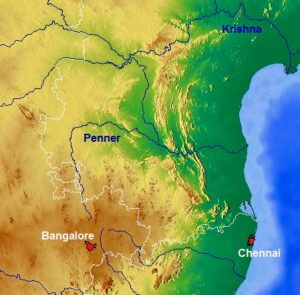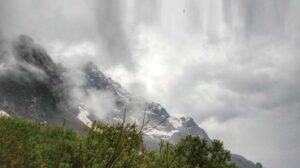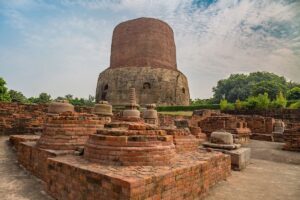Daily Current Affairs – 18 Sep. 2025
Daily Current Affairs – 18 Sep. 2025
Himalayan Rains
Daily Current Affairs: Key Highlights and Insights
Dehradun and several districts of Uttarakhand have seen very heavy rainfall in recent days, triggering landslides, swollen rivers, and at least 15 deaths. Over the past month, both Uttarakhand and Himachal Pradesh have witnessed repeated incidents of cloudbursts, flash floods, mudslides, and damaged communication networks.
While such events are typical of the monsoon, their growing frequency and intensity in recent years have raised serious concerns about safety and resilience in the Himalayan region.
Why Hilly Regions Receive More Rainfall?
- This monsoon, the northwestern region has seen unusually high rainfall, with 34% surplus in August and over 67% above normal in early September.
- Consecutive low-pressure systems from the Bay of Bengal moved farther north, intensifying
- In hilly areas like the western Himalayas, geography amplifies the impact: rising air forms massive, steep clouds that release heavy local precipitation.
- Such rainfall levels, manageable in coastal states like Goa or Kerala, trigger disasters in
- For example, Udhampur in J&K recorded 630 mm in 24 hours — equal to Rajkot’s annual rainfall while Leh received 59 mm in two days, a record since 1973.
Why Hilly Regions Face Greater Disaster Risks?
- In plains, heavy rainfall usually drains into rivers or local water bodies, but in mountains it often triggers landslides, mudslides, and flash floods as water rushes downhill carrying mud, soil, and debris.
- This has recently occurred in Mandi, Kullu, Dharali, Tharali, and
- When major rivers get choked, overflowing water and debris can inundate settlements, destroying roads and bridges.
- However, not every cloudburst results in disaster — the impact depends on local factors, such as slope stability and whether debris falls into river channels.
Climate Change and Himalayan Rainfall Extremes –
- Recent years show a southward shift of western disturbances — wind systems from the Mediterranean that bring rain and snow to northern India.
- Their increasing interaction with southwest monsoon currents, driven by global warming, has complicated rainfall patterns over the Himalayas.
- This shift is linked to more frequent extreme rainfall events and longer dry
- Additionally, Arctic Sea ice melting may further influence these changing monsoon dynamics, raising concerns about heightened climate risks in hilly regions.
Why the Himalayas Are Prone to Cloudbursts?
- The Himalayas, positioned where moist tropical monsoon winds meet mid-latitude westerlies, experience strong uplift and instability that often trigger cloudbursts.
- Warm, moisture-rich air forced up the slopes cools quickly, condenses, and produces intense, localised downpours.
- Climate change is worsening this vulnerability: rapid Arctic warming weakens the jet stream, causing westerly troughs to interact more with monsoon currents, while warmer air carries more moisture, intensifying rainfall.
- A slower, wavering jet stream makes storms linger, leading to prolonged heavy rain and devastating floods — trends already seen globally, including in Germany (2021), Pakistan (2010), and West Asia (2024).
Observational Tools and Their Limitations in Forecasting Cloudbursts –
- Cloudburst forecasting relies on Doppler Weather Radars (DWRs), satellites, rain gauges, GPS- based moisture monitoring, and high-resolution numerical weather prediction (NWP) models.
- While DWRs provide detailed cloud and rainfall structures, their coverage is limited in Himalayan terrain.
- Rain gauges and automatic weather stations offer accurate point data but lack spatial
- Satellites like INSAT-3D/3DR, GPM, and Himawari capture convective growth and rainfall but struggle with coarse resolution and biases in rugged topography.
- NWP models simulate convection and storm dynamics but require very fine resolution (<1 km), precise initial conditions, and explicit process representation, making sudden bursts hard to
- To improve accuracy, denser observation networks, advanced models with better cloudburst representation, and AI/ML integration for data assimilation are essential.
NPS to UPS
Central government employees have until September 30 to opt for the Unified Pension Scheme (UPS) under NPS (National Pension System), introduced in April 2025. Despite 23.94 lakh employees being eligible, only around 40,000 have opted so far.
To regulate service matters for those choosing UPS, the Department of Pension and Pensioners’ Welfare notified the Central Civil Services (Implementation of the Unified Pension Scheme under the National Pension System) Rules, 2025, on September 2.
Government Extends UPS Option to New Employees –
- The government has allowed central employees who joined between April 1 and August 31, 2025, under NPS to migrate to the Unified Pension Scheme (UPS).
- This one-time option, available until September 30, 2025, aligns with the existing cut-off for other eligible categories.
- Employees opting for UPS will also retain the right to later switch back to NPS, ensuring flexibility in planning post-retirement financial security.
• Switch Option from UPS to NPS —
- UPS subscribers have a one-time option to switch to NPS, but cannot return to UPS.
- The switch must be exercised at least one year before retirement or three months before VRS, and is barred in cases of dismissal, removal, compulsory retirement, or pending disciplinary proceedings.
- Those not opting will remain under
- Employees switching to NPS will receive its benefits along with the differential 4% contribution, giving greater flexibility and informed choice for retirement planning.
Unified Pension Scheme (UPS) –
- Before UPS, central government employees hired before January 1, 2004, were covered under the Old Pension Scheme (OPS), which guaranteed fixed pensions, while those joining after were under the market-linked National Pension System (NPS).
- Amid persistent demands to restore OPS, the Union Cabinet approved the Unified Pension Scheme (UPS) in August 2024 as an optional scheme.
• About UPS —
- From April 1, 2025, the government introduced the UPS as an option under NPS for central government employees hired after January 1, 2004.
- Around 23 lakh employees can choose between NPS and
- Unlike NPS, UPS guarantees an assured pension: 50% of the average basic pay of the last 12 months before retirement, provided the employee has served a minimum of 25 years.
- In case of the pensioner’s death, the spouse will receive up to 60% of the pension being
- Unlike the Old Pension Scheme, which guaranteed 50% of last drawn basic pay without employee contribution, UPS combines assured benefits with mandatory contributions.
Key Differences Between UPS and NPS –
- The NPS is mandatory, while the UPS is optional, with employees given a one-time chance to switch back to NPS before retirement or VRS.
- Under the NPS, through the Permanent Retirement Account Number (PRAN), employees contribute 10% and the employer 14% of basic pay plus dearness allowance (DA), with pension benefits entirely dependent on the accumulated corpus.
- In contrast, the UPS requires 10% contributions each from employee and employer, with an additional 8.5% contribution by the government to create a pool corpus.
- This pool funds an assured pension of 50% of the employee’s average basic pay over the last 12 months, provided a minimum of 25 years of service is completed.
- Unlike NPS, UPS guarantees a minimum monthly payout of ₹10,000 after 10 years of service, ensuring greater financial security.
- UPS also offers a lump sum equal to one-tenth of the last basic pay plus DA for every six months of service, whereas NPS has no such provision.
- Employees dismissed from service are ineligible for the assured UPS
Why the Unified Pension Scheme Is Slow to Take Off?
- Although the government extended the deadline to September 30 for employees to opt into the Unified Pension Scheme (UPS), uptake remains low.
- The Department of Pension is holding awareness drives, but many employees still prefer the Old Pension Scheme (OPS), which required no employee contribution and guaranteed 50% of the last drawn basic pay plus DA as pension.
- In contrast, UPS involves contributions and is seen as less
- The Central Secretariat Service Forum has also criticised both NPS and UPS, reiterating its demand for a complete return to OPS.
Sarnath Plaque
The Archaeological Survey of India (ASI) is revising the Sarnath plaque to credit the Benares ruler’s family, instead of the British, for preserving the heritage site ahead of a UNESCO team’s visit.
About Sarnath –
- Located about 10 km from Varanasi in Uttar Pradesh, it is one of the most revered sites in the Buddhist world.
- It holds immense historical, cultural, and religious significance as the place where Gautama Buddha delivered his first sermon after attaining enlightenment at Bodh Gaya.
- Known as the Dharmachakra Pravartana or Turning of the Wheel of Dharma, this event marked the formal beginning of the Buddhist Sangha (community).
Historical Significance –
- Buddha’s First Sermon — Around 528 BCE, Buddha preached the Four Noble Truths and the Eightfold Path here to his five ascetic disciples. This sermon became the foundational philosophy of Buddhism.
- Mauryan Patronage — Emperor Ashoka (3rd century BCE), after embracing Buddhism, visited Sarnath and commissioned several stupas, monasteries, and pillars. The famous Ashokan Lion Capital, India’s national emblem, was erected here.
- Medieval Flourishing — Over centuries, Sarnath grew into a vibrant monastic and educational hub. Numerous monasteries, stupas, and sculptures were added, especially under the Gupta dynasty (4th-6th century CE), which produced exquisite Buddhist art.
- Decline — With the decline of Buddhism in India (around the 12th century CE) and repeated invasions, Sarnath fell into ruin and was largely forgotten until rediscovery in the colonial era.
Key Monuments and Structures –
• Dhamek Stupa —
- Built initially by Ashoka and later enlarged, this massive cylindrical stupa (43.6 meters high, 28 meters in diameter) marks the exact spot of Buddha’s first sermon.
- The lower portion is decorated with intricate floral and geometric patterns, characteristic of Gupta art.
• Chaukhandi Stupa —
- An early stupa commemorating the meeting between Buddha and his first
- Later, a Mughal-era pavilion was added to the
• Ashokan Pillar —
- The pillar, erected by Ashoka, bore the famous Lion Capital of Ashoka, now preserved in the Sarnath Archaeological Museum.
- The capital, with four lions back-to-back, is India’s National Emblem and also featured on Indian currency.
• Mulagandha Kuti Vihar —
- A modern monastery built by the Mahabodhi Society in 1931, it contains impressive frescoes depicting scenes from Buddha’s life.
• Monastic Ruins —
- The site contains remains of monasteries that once hosted thousands of monks, serving as a leading centre of Buddhist learning.
Debate Over Historical Attribution –
- For decades, the mainstream narrative credited British officials such as Duncan and Mackenzie in 1798 and later archaeologists like Alexander Cunningham for discovering and preserving
- However, recent scholarship and archival records challenge this view, pointing to Jagat Singh’s excavation in 1787-88 as the actual turning point.
- His digging at the ancient mound unearthed Buddhist relics, shifting the perception of who deserves credit for uncovering Sarnath’s legacy.
- This change is not merely a matter of rewriting history; it reflects a broader attempt to decolonise India’s historical narratives and recognise indigenous agency in heritage
Background of the Case –
- Jagat Singh, a descendant of Benares ruler Chait Singh, ordered excavation at Sarnath for construction purposes, which unexpectedly revealed Buddhist Parts of these relics remain housed in the Asiatic Society in Kolkata.
- The existing plaque at Sarnath emphasises British-led excavations from 1798 onwards, overshadowing Singh’s contribution.
- Earlier this year, following a petition by Singh’s descendants, the ASI revised a separate plaque at the Dharmarajika Stupa, removing language that labelled him a “destroyer” of monuments.
- The new version acknowledged that the stupa came to light through his actions, highlighting the contested nature of colonial-era historical narratives.
Summary of Recent Developments –
- The upcoming plaque revision at Sarnath comes as UNESCO evaluates India’s proposal to include the site in its World Heritage List.
- ASI’s New Decision — The corrected plaque will formally acknowledge Jagat Singh’s role in exposing Sarnath’s importance in 1787-88, predating British accounts by a decade.
- Research Support — Former National Museum Director B.R. Mani’s excavations have revealed evidence of Buddhist activity at Sarnath even before Emperor Ashoka, strengthening the case for recognising local contributions.
- Cultural Impact — Singh’s family has also requested the ASI to revise accompanying cultural notice boards to reflect the corrected history.
- Broader Context — India’s cultural diplomacy emphasises its Buddhist heritage globally. The revision of plaques aligns with this strategy, especially as South Asian tourists form a large segment of visitors to Sarnath.
- UNESCO Candidacy — Sarnath, long on UNESCO’s tentative list, is now a strong contender for inclusion, with the government keen to assert its cultural and historical primacy.
WTO Agreement on Fisheries Subsidies
Recently, the World Trade Organisation’s agreement on Fisheries Subsidies came into force.
About WTO Agreement on Fisheries Subsidies –
- The Agreement on Fisheries Subsidies is the WTO’s first multilateral agreement with environmental sustainability at its core.
- It prohibits government support to illegal fishing activities and overexploitation of stocks, contributing to the protection of marine life.
- It was adopted at the 12th Ministerial Conference (MC12) in 2022, in
• The agreement establishes —
- The first global trade rules designed to curb harmful fisheries
- Prohibits subsidies that support illegal, unreported and unregulated(IUU) fishing, fishing activities targeting overfished stocks
- It also covers fishing in areas of the high seas that are not covered by a regional fisheries management organisation.
• Implementation of the Agreement —
- WTO Fish Fund: Ministers have established this fund to provide developing economies and least-developed countries (LDCs) with technical assistance and capacity-building needed to implement the new obligations and manage their own fisheries more
- Seventeen members have pledged the equivalent of more than USD 18 million to the WTO Fish Fund.
- Following its entry into force this month, a Committee on Fisheries Subsidies will be created to monitor compliance, review members’ notifications on their subsidy programmes.
- WTO members will be required to report details of their fishing subsidies, as well as data such as fish stock levels and conservation measures in place.
International Labour Organisation
Recently, the Union Minister of Labour & Employment signed the Memorandum of Understanding between Government of India and International Labour Organisation (ILO) for collaboration to develop ‘International Reference Classification of Occupations’.
About International Labour Organisation –
- It is a specialised agency of the United Nations (UN) dedicated to improving labour conditions and living standards throughout the world.
- It is the only tripartite N. agency that brings together governments, employers and workers’ representatives of 187-member States.
• History of International Labour Organisation —
- It was created in 1919, as part of the Treaty of Versailles that ended World War I
- In 1946, the ILO became a specialised agency of the newly formed
- It is also a member of the United Nations Development Group (UNDP), a coalition of UN organisations aimed at helping meet the Sustainable Development Goals.
- Member countries — It has 187 member states: 186 out of 193 UN member states plus the Cook Islands.
• Functions of International Labour Organisation —
- Policy Formulation: It forms international policies and programmes to promote basic human rights, improve working and living conditions, and enhance employment opportunities
- Creation of international labour standards backed by a unique system to supervise their application
- An extensive programme of international technical cooperation formulated and implemented in an active partnership with constituents, to help countries put these policies into practice in an effective manner
- Training, education, and research activities to help advance all of these
- In recognition of its activities, the ILO was awarded the Nobel Prize for Peace in
- Headquarter: Geneva,
Almatti Dam
To set the stage for the implementation of the languishing Upper Krishna Project (UKP) phase III, the Karnataka Cabinet recently gave clearance for the acquisition of 1,33,867 lakh acres of land to facilitate the increase of Almatti dam’s height from the present 519.16 metres to 524.256 metres.
About Almatti Dam –
- It is a hydroelectric project on the Krishna River in North
- The dam was completed in July 2005.
- It was built with the primary objectives of supplying irrigation and potable water to adjacent regions, generating hydroelectric energy, and managing flood risks in the area.
- The annual electric output of the dam is 713,000,000 kilowatts (KW).
- The dam holds a gross water storage capacity of 08 TMC at 519 meters MSL.
- Standing at a height of 52.5 meters and extending 3.5 kilometers in length, Almatti Dam serves as the principal reservoir of the Upper Krishna Irrigation Project; the 290 MW power station is located on the right side of the Almatti Dam.
- The facility uses vertical Kaplan turbines: five 55 MW generators and one 15 MW
- Two separate facilities, namely, Almatti 1 Powerhouse and Almatti II Powerhouse, each separated by distance, do provide power generation capabilities.
- After generating power, water is released into the Narayanpur reservoir to meet the irrigation requirements downstream.
- 77 acres surrounding Almatti Dam have been developed into meticulously maintained gardens, including the Japanese Garden, Rock Garden, Mughal Garden, Gopal Krishna Garden, and Lavakush Garden.
Hand, Foot, and Mouth Disease (HFMD)
A viral infection known as Hand, Foot, and Mouth Disease (HFMD) is spreading rapidly among children across Delhi and neighbouring Haryana, prompting health experts and schools to issue advisories.
About Hand, Foot, and Mouth Disease (HFMD) –
- It is a very contagious illness caused by a
- The disease gets its name from the blister-like rash that forms on your child’s hands and feet and painful sores that develop in their mouth.
- The rash can actually appear anywhere on their body, including their chest, back, arms, legs, genitals, and buttocks.
- Infants and children younger than 5 are most likely to get HFMD.
- It is extremely uncommon in adults; however, it is still a possibility.
- It tends to spread quickly among children in daycare and school
- Because several viruses can cause the disease, it’s possible to get HFMD multiple
- It is often confused with foot-and-mouth (also called hoof-and-mouth) disease, a disease of cattle, sheep, and swine; however, the two diseases are not related—they are caused by different viruses.
- Humans do not get the animal disease, and animals do not get the human disease.
- Transmission — It easily spreads through contact with unwashed hands, faeces, saliva , mucus from the nose, or fluid from the blisters.
• Symptoms:
- Fever
- Sore throat
- Painful mouth sores that blister
- Rash commonly found on the hands and feet
- Complications from HFMD are
• Treatment —
- There is no cure for HFM and no vaccine to prevent
- Most people get better on their own in 7 to 10 days with minimal or no medical
- However, it can take children younger than 2 years old a little longer for their bodies to clear the virus
Ion Chromatography
Scientists recently devised a way to perform ion chromatography in the field.
 About Ion Chromatography –
About Ion Chromatography –
- Ion chromatography (IC), or ion exchange chromatography, is a powerful analytical technique used to separate and quantify ions in a sample.
• It separates charged molecules based on their affinity to the ion-exchange resin.
- Ion chromatography techniques of various types enable scientists to target specific ions or classes of ions, providing precise and sensitive analysis.
• It is of two types: cation exchange and anion exchange.
- Ion chromatographs are able to measure concentrations of major anions, such as fluoride, chloride, nitrate, nitrite, and sulfate, as well as major cations, such as lithium, sodium, ammonium, potassium, calcium, and magnesium, in the parts-per-billion (ppb)
- Concentrations of organic acids can also be measured through ion
- How Does Ion Chromatography Work?
- Ion chromatography, a form of liquid chromatography, measures concentrations of ionic species by separating them based on their interaction with a resin.
- Ionic species separate differently depending on species type and
- Sample solutions pass through a pressurised chromatographic column where ions are absorbed by column constituents
- As an ion extraction liquid, known as eluent, runs through the column, the absorbed ions begin separating from the column.
- The retention time of different species determines the ionic concentrations in the sample.
- Applications —
- Drinking water analysis for pollution and other
- Determination of water chemistries in aquatic ecosystem.
- Determination of sugar and salt content in Isolation of select proteins.
Frontier 50 Initiative
Recently, the NITI Aayog launched the Frontier 50 Initiative to amplify grassroots adoption of technology and scale impact creation.
About Frontier 50 Initiative –
- It will support 50 Aspirational Districts / Blocks to pick use cases from the Repository and deploy those frontier technologies that have potential to accelerate saturation of services across ADP/ABP themes.
- Launched by: NITI Aayog under its Frontier Tech
- The Frontier Tech Repository showcases 200+ impact stories from across India in four sectors –
Agriculture, Healthcare, Education, and National Security.
- It brings to life how states and startups are deploying technology with the purpose to transform
What is NITI Frontier Tech Hub?
- It has been established to anticipate mega technology shifts and chart India’s readiness to unlock their potential for inclusive growth, supply chain resilience, and national security.
- It convenes leading experts across government, industry, and academia to assess frontier technologies—such as AI, quantum, and biotechnology.
- It evaluates AI, quantum, and biotechnology opportunities and risks for India, and designs strategies to harness them for Viksit Bharat@204
Bureau of Indian Standards
In recent years, the Bureau of Indian Standards (BIS) has issued as many as 84 Quality Control Orders (QCOs) based on the recommendations of various ministries and departments.
About Bureau of Indian Standards –
- It is the National Standard Body of India established under the BIS Act
- Objective — It was established for the harmonious development of the activities of standardisation, marking, and quality certification of goods and for matters connected therewith or incidental thereto.
- It is the successor of the Indian Standards Institution (ISI), which was created in 1947 to ensure quality control and competitive efficiency in the rapid industrialisation era.
• Functions of Bureau of Indian Standards —
- BIS has been providing traceability and tangibility benefits to the national economy in a number of ways by
- Providing safe, reliable quality goods;
- Minimising health hazards to consumers;
- Promoting exports and imports substitute; control over proliferation of varieties etc. through standardisation, certification, and testing.
- It operates product certification schemes through which it grants licenses to manufacturers covering practically every industrial discipline, from agriculture and textiles to
- BIS represents India in International Organisation for Standardisation (ISO) and International Electrotechnical Commission (IEC).
- Nodal Ministry — It is functioning under the administrative control of the Ministry of Consumer Affairs, Food and Public Distribution.
- Headquarter — It is headquartered in New Delhi and maintains regional and branch offices throughout the country.
Birhor Tribe
Around 550 residents, mostly belonging to the Birhor tribe, of Fulwariya hamlet in Koderma district would soon receive electricity supply, ending nearly eight decades of darkness.
About Birhor Tribe –
- The Birhor are a forest-dependent semi-nomadic tribal community concentrated in the eastern central Indian state of Jharkhand.
- Some of them are also found in Chhattisgarh, Odisha, and West
- The Birhor community is one of eight Particularly Vulnerable Tribal Groups (PVTGs) identified in Jharkhand.
- The term “Birhor” is derived from the words “Bi”, meaning “Jungle”, and “hor”, meaning “man”; thus, it means “the man living in Jungle” or “people of Jungle”.
- They belong to the Porto-Australoid
- Religion — The Birhor follow a mixture of animism and
• Language —
- The Birhor tribes have their own language, known as Birhor, which belongs to the Munda group of languages of the Austroasiatic language family.
- Their language has similarities with the Santali, Mundari, and Ho
- However, due to increased contact with other communities and the influence of mainstream languages, many Birhor people are bilingual or trilingual, with proficiency in Hindi,
Bengali, or other regional languages.
• Ethnology —
- The Birhors are of short stature, with long heads, wavy hair, and broad
- They claim they have descended from the Sun and believe that the Kharwars, who also trace their descent from the Sun, are their brothers.
- Ethnologically, they are akin to the Santals, Mundas, and Hos.
• Society —
- They typically live in small, close-knit communities, and their social organisation is primarily based on kinship ties.
- The tribe is divided into several clans, and each clan has its own leader who plays a crucial role in resolving disputes and maintaining social harmony within the community.
- They live in small settlements in the forest or on the outskirts of
- The temporary Birhor settlements are known as tandas or
- These consist of at least half a dozen huts of conical shape, erected with leaves and
- Birhor society is characterised by a strong sense of community, cooperation, and mutual
• Economy —
- The “primitive subsistence economy” of the Birhors has been based on nomadic gathering and hunting, particularly for monkeys.
- They make ropes out of the fibres of a particular species of vine, which they sell in the markets of the nearby agricultural people.
• Some of them have settled into stable agriculture.
- According to socio-economic standing, the Birhors are classified into two While the wandering Birhors are called Uthlus, the settled Birhors are called Janghis.
- The Birhor tribe has a rich knowledge of traditional medicine and uses various medicinal plants found in the forest for treating common ailments.
Saunders’s Tern
Recently, Saunders’s Tern was sighted at Adyar Estuary in Chennai.
About Saunders’s Tern –
- It is a species of bird in the family
- Saunders’s terns (Sternula saundersi) are a small, ground-nesting marine bird
- It is sparsely resident along the shores of the north-western Indian
- Geographical Range: It breeds in the Red Sea and Persian Gulf to islands between India and Sri Lanka; apparently winters mainly Seychelles to Maldives and Cocos (Keeling) Island.
- Habitat: This species occupies a variety of coastal areas: estuaries, shallow tropical and subtropical inshore waters, tidal lagoons, and harbours.
- Food: Its diet comprises many kinds of marine animals, such as small fish, crustaceans, and
- It nests on the ground up to 2 km inland on uncovered sandy sites, shingles, or dried
- Breeding Season: The breeding season for the Saunders’s tern is between March and
• Conservation Status: Least Concern (IUCN Red List).
Key Facts about the Adyar estuary –
- It is formed by the Adyar River at the point at which the river meets the Bay of
- It lies between Santhome beach in the north and Elliots Beach in the
Penna River
Eighteen youngsters stranded in the floodwaters of the Penna River in the Nellore district of Andhra Pradesh recently were rescued after a seven-hour operation.
 About Penna River –
About Penna River –
- The Penna River, also known as Pennar, Pinakini, or Penneru, is a river in southern India that flows through the states of Karnataka and Andhra Pradesh.
• Course —
- Origin: It rises in the Nandi Hills, an upland region on the Deccan plateau, in Karnataka’s Chikkaballapur district.
- It flows north into Andhra Pradesh state and turns east and then southea
- After passage through a gap in the Eastern Ghats range, it again bends east toward the Coromandel Coast, emptying into the Bay of Bengal near the Nellore district.
- It has a total length of about 597
• The river basin lies in the rain shadow region of the Eastern Ghats.
- The river is seasonal, becoming a torrent after the rains and a thin stream during dry
• Tributaries —
- The Penna River has several tributaries, most of which are seasonal.
- Major ones include the Chitravati, Papagni, Cheyyeru, and Kunderu
- The Penna River is crucial to agriculture in parts of Andhra Pradesh, particularly the drought- stricken Rayalaseema region.
- Several irrigation projects, such as the Somasila, Mylavaram, and Gandikota projects, have been constructed to use the river’s waters for farming and drinking purposes.
MCQs
1. With reference to the Unified Pension Scheme (UPS), recently notified by the Union Finance Ministry, consider the following statements —
- The Unified Pension Scheme (UPS) applies only to future Central Government employees and not to those currently under the National Pension System (NPS).
- Under the UPS, an assured payout of 50% of the average basic pay drawn during the last 12 months prior to retirement is guaranteed, provided the employee has completed at least 25 years of service.
- The Unified Pension Scheme (UPS) is non-contributory and entirely funded by the central
Which of the statements given above is/are correct?
- 1 and 2 only
- 2 only
- 3 only
- All of the above
Answer – B
Explanation – The UPS is applicable to both current and future Central Government employees under the NPS, provided they choose to opt for it. The UPS guarantees an assured payout of 50% of the average basic pay of the last 12 months prior to retirement for employees who have completed 25 years of service. The UPS is contributory in nature, requiring a 10% contribution from employees and 18.5% from the central government.
2. Which of the following statement(s) is/are correct about the ‘New Pension Scheme’?
- It encourages people to invest in a pension account at regular intervals during the course of their employment.
- Any Indian citizen (including NRIs) between 18 and 60 years of age can join the
- The money invested in NPS is managed by Pension Fund Regulatory and Development
Select the correct codes from below –
- 1 and 2 only
- 2 and 3 only
- 1 and 3 only
- All of the above
Answer – A
Explanation – As a substitute of OPS, the NPS was introduced by the Central government in April, 2004. This pension programme is open to employees from the public, private and even the unorganised sectors except those from the armed forces. The scheme encourages people to invest in a pension account at regular intervals during the course of their employment. After retirement, the subscribers can take out a certain percentage of the corpus. The beneficiary receives the remaining amount as a monthly pension, post retirement. Nodal agency — Pension Fund Regulatory and Development Authority (PFRDA). Eligibility — Any Indian citizen between 18 and 60 years can join NPS. NRIs (Non-Residential Indians) are also eligible to apply for NPS. Permanent Retirement Account Number (PRAN) — Every NPS subscriber is issued a card with 12-digit unique number called Permanent Retirement Account Number or PRAN. Minimum contribution in NPS — The subscriber has to contribute a minimum of Rs. 6,000 in a financial year. If the subscriber fails to contribute the minimum amount, his/her account is frozen by the PFRDA. Management of the money invested in NPS — The money invested in NPS is managed by PFRDA-registered Pension Fund Managers. At the moment, there are eight pension fund managers.
3. Which of the following statements is/are correct about Buddha?
- Buddha taught that life is full of suffering and
- Stupa at Bodh Gaya was built to mark the place where Buddha first taught his
Select the correct codes from below –
- 1 only
- 2 only
- Both 1 and 2
- Neither 1 nor 2
Answer – A
Explanation – Stupa at Sarnath was built to mark the place where the Buddha first taught his message.
4. Which of the following statement(s) is/are correct about the ‘International Labour Organisation’?
- It was established in the year 1946 as the specialised agency of the United
- Despite being instrumental in improving peace among classes, it has never been awarded the Nobel Peace Prize since its inception.
- India has recently assumed the chairmanship of the Governing Body of the International Labour Organisation.
Select the correct codes from below –
- 1 and 2 only
- 2 and 3 only
- 1 and 3 only
- All of the above
Answer – C
Explanation – International Labour Organisation was established in the year 1919 by the Treaty of Versailles as an affiliated agency of the League of Nations. It became the first affiliated specialised agency of the United Nations in 1946. Its headquarters is located in Geneva, Switzerland. Objectives – It promotes internationally recognised human and labour rights. It aims promote and realise standards and fundamental principles and rights at work; create greater opportunities for women and men to secure decent employment; enhance the coverage and effectiveness of social protection for all, and; strengthen tripartism and social dialogue. It has received the Nobel Peace Prize in 1969 for improving peace among classes, pursuing decent work and justice for workers, and providing technical assistance to other developing nations. After 35 years, India has assumed the Chairmanship of the Governing Body of International Labour Organisation, marking a new chapter in the 100 years of productive relationship between India and ILO.
5. The ‘Bureau of Indian Standards’ under the purview of –
- Ministry of Commerce and Industry
- Ministry of Science and Technology
- Ministry of Consumer Affairs
- None of the above
Answer – C
Explanation – BIS is the only national body that frames standards. It works under the aegis of Ministry of Consumer Affairs, Food & Public Distribution, Government of India. BIS is responsible for the harmonious development of the activities of standardisation, marking and quality certification of goods etc. The Bureau of Indian standards (BIS) Act 2016 establishes the Bureau of Indian Standards (BIS) as the National Standards Body of India.
- The Act enables the Central Government to appoint any authority/agency, in addition to the BIS, to verify the conformity of products and services with the established standard and issue certificate of conformity.
- There is a provision for repair or recall, of the products (bearing Standard Mark) that do not conform to the relevant Indian Standard.









